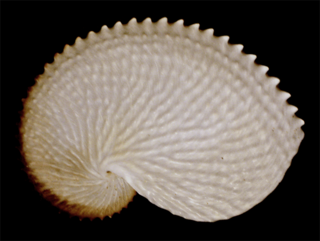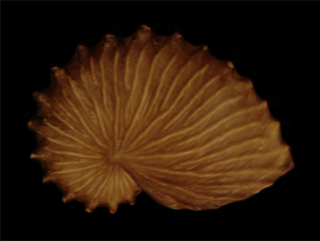
The Argonautidae are a family of pelagic cephalopods that inhabit tropical and temperate oceans of the world. The family encompasses the modern paper nautiluses of the genus Argonauta along with several extinct genera of shelled octopods. Though argonauts are derived from benthic octopuses, they have evolved to depart the sea floor and live their life-cycle in the open seas.

The argonauts are a group of pelagic octopuses. They are also called paper nautili, referring to the paper-thin eggcase that females secrete. This structure lacks the gas-filled chambers present in chambered nautilus shells and is not a true cephalopod shell, but rather an evolutionary innovation unique to the genus. It is used as a brood chamber, and to trap surface air to maintain buoyancy. It was once speculated that argonauts did not manufacture their eggcases but utilized shells abandoned by other organisms, in the manner of hermit crabs. Experiments by pioneering marine biologist Jeanne Villepreux-Power in the early 19th century disproved this hypothesis, as Villepreux-Power successfully reared argonaut young and observed their shells' development.

Argonauta argo, also known as the greater argonaut, is a species of pelagic octopus belonging to the genus Argonauta. The Chinese name for this species translates as "white sea-horse's nest".

Argonauta nouryi, also known as Noury's argonaut, is a species of pelagic octopus. The female of the species, like all argonauts, creates a paper-thin eggcase that coils around the octopus much like the way a nautilus lives in its shell. The shell is usually approximately 80 mm in length, although it can exceed 90 mm in exceptional specimens; the world record size is 95.5 mm.

Argonauta hians, also known as the winged argonaut, muddy argonaut or brown paper nautilus, is a species of pelagic octopus. The common name comes from the grey to brown coloured shell. The Chinese name for this species translates as "Grey Sea-horse's Nest". The female of the species, like all argonauts, creates a paper-thin eggcase that coils around the octopus much like the way a nautilus lives in its shell. The eggcase is characterised by a wide keel that gives it a square appearance, few rounded tubercles along the keel, and less than 40 smooth ribs across the sides of the shell. The shell is usually approximately 80 mm in length, although it can exceed 120 mm in exceptional specimens; the world record size is 121.5 mm.

Argonauta cornuta is a species of pelagic octopus belonging to the genus Argonauta. The female of the species, like all argonauts, creates a paper-thin eggcase that coils around the octopus reminiscent of the way a nautilus lives in its shell. The shell is usually approximately 80 mm in length, although it can exceed 90 mm in exceptional specimens; the world record size is 98.6 mm.

Argonauta pacifica, also known as the Pacific argonaut, is a species of pelagic octopus. The female of the species, like all argonauts, creates a paper-thin eggcase that coils around the octopus much like the way a nautilus lives in its shell. The shell is usually approximately 150 mm in length, although it can exceed 200 mm in exceptional specimens; the world record size is 220.0 mm.

Argonauta nodosus [previously known as Argonauta nodosa], also known as the knobby or knobbed argonaut, is a species of pelagic octopus. The female of the species, like all argonauts, creates a paper-thin eggcase that coils around the octopus much like the way a nautilus lives in its shell. The shell is usually approximately 150 mm in length, although it can exceed 250 mm in exceptional specimens; the world record size is 292.0 mm. A. nodosus produces a very characteristic shell, which is covered in many small nodules on the ridges across the shell, hence the specific epithet nodosus and common name. These nodules are less obvious or even absent in juvenile females, especially those under 5 cm in length. All other argonaut species have smooth ridges across the shell walls.

Argonauta bottgeri, also known as Böttger's argonaut, is a species of pelagic octopus belonging to the genus Argonauta. The female of the species, like all argonauts, creates a paper-thin eggcase that coils around the octopus much like the way a nautilus lives in its shell.

Obinautilus is an extinct genus of shelled cephalopod that has been variously identified as an argonautid octopod or a nautilid. It is known from the Late Oligocene to Pliocene of Japan. The shell is discoidal and very involute, with rapidly expanding and compressed whorls, fine radial ribs, a rounded venter with a shallow furrow, and almost closed umbilicus.
†Argonauta absyrtus is an extinct species of octopus assigned to the genus Argonauta.
Argonauta tokunagai is an extinct species of octopus. It was described in 1913 based on fossil material from the Middle Miocene Huzina Formation of Japan.

Nakalipithecus nakayamai is an extinct species of great ape from Nakali, Kenya, from about 9.9–9.8 million years ago during the Late Miocene. It is known from a right jawbone with 3 molars and from 11 isolated teeth, and the specimen is presumed female as the teeth are similar in size to those of female gorillas and orangutans. Compared to other great apes, the canines are short, the enamel is thin, and the molars are flatter. Nakalipithecus seems to have inhabited a sclerophyllous woodland environment.

The Gibraltar Arc is a geological region corresponding to an arcuate orogen surrounding the Alboran Sea, between the Iberian Peninsula and Africa. It consists of the Betic Cordillera, and the Rif. The Gibraltar Arc is located at the western end of the Mediterranean Alpine belt and formed during the Neogene due to convergence of the Eurasian and African plates.
?Oryzomys pliocaenicus is a fossil rodent from the Hemphillian of Kansas, central United States. It is known from a single mandible with the back part missing. All three molars are present, but very worn. Together, the molars are 3.6 mm long. The fossil was discovered in 1935 and described in 1939 as a possible species of Oryzomys. Later authors doubted this allocation and suggested that it may instead belong in Bensonomys or Jacobsomys, but the material may not allow a definite identification.
Argonauta oweri is an extinct species of argonautid octopus. It is known from the early Pliocene of New Zealand.

Scaldicetus is an extinct genus of highly predatory macroraptorial sperm whale. Although widely used for a number of extinct physeterids with primitive dental morphology consisting of enameled teeth, Scaldicetus as generally recognized appears to be a wastebasket taxon filled with more-or-less unrelated primitive sperm whales.

Stemmiulida is an order of millipedes consisting of approximately 130 species, reaching up to 50 mm in length. It contains a single family, Stemmiulidae.














